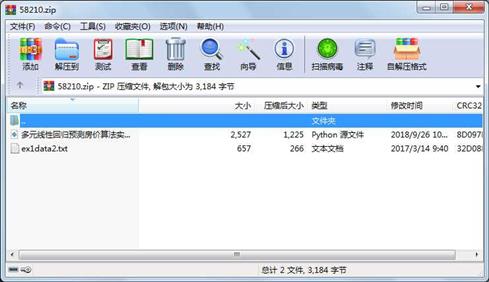资源简介
#多元线性回归预测房子的价格,构建一个房子价格的python模型。
##ex1data2.txt中包含了房子价格的训练组。第一列是房子的尺寸(平方英尺),第二列是卧室的数量,第三列是房子的价格。

代码片段和文件信息
##多元线性回归预测房子的价格,构建一个房子价格的模型。
##ex1data2.txt中包含了房子价格的训练组。第一列是房子的尺寸(平方英尺),第二列是卧室的数量,第三列是房子的价格。
#-*- coding: UTF-8 -*-
import random
import numpy as np
import matplotlib.pyplot as plt
#加载数据
def load_exdata(filename):
data = []
with open(filename ‘r‘) as f:
for line in f.readlines():
line = line.split(‘‘)
current = [int(item) for item in line] #根据数据输入的不同确定是int 还是其他类型
#5.52779.1302
data.append(current)
return data
data = load_exdata(‘ex1data2.txt‘);
data = np.array(datanp.int64) #根据数据输入的不同确定是int 还是其他类型
#特征缩放
def featureNormalize(X):
X_norm = X;
mu = np.zeros((1X.shape[1]))
sigma = np.zeros((1X.shape[1]))
for i in range(X.shape[1]):
mu[0i] = np.mean(X[:i]) # 均值
sigma[0i] = np.std(X[:i]) # 标准差
# print(mu)
# print(sigma)
X_norm = (X - mu) / sigma
return X_normmusigma
#计算损失
def computeCost(X y theta):
m = y.shape[0]
# J = (np.sum((X.dot(theta) - y)**2)) / (2*m)
C = X.dot(theta) - y
J2 = (C.T.dot(C))/ (2*m)
return J2
#梯度下降
def gradientDescent(X y theta alpha num_iters):
m = y.shape[0]
#print(m)
# 存储历史误差
J_history = np.zeros((num_iters 1))
for iter in range(num_iters):
# 对J求导,得到 alpha/m * (WX - Y)*x(i), (3m)*(m1) X (m3)*(31) = (m1)
theta = theta - (alpha/m) * (X.T.dot(X.dot(theta) - y))
J_history[iter] = computeCost(X y theta)
return J_historytheta
iterations = 10000 #迭代次数
alpha = 0.01 #学习率
x = data[:(01)].reshape((-12))
y = data[:2].reshape((-11))
m = y.shape[0]
xmusigma = featureNormalize(x)
X = np.hstack([xnp.ones((x.shape[0] 1))])
# X = X[range(2):]
# y = y[range(2):]
theta = np.zeros((3 1))
j = computeCost(Xytheta)
J_historytheta = gradientDescent(X y theta alpha iterations)
print(‘Theta found by gradient descent‘theta)
def predict(data):
testx = np.array(data)
testx = ((testx - mu) / sigma)
testx = np.hstack([testxnp.ones((testx.shape[0] 1))])
price = testx.dot(theta)
print(‘price is %d ‘ % (price))
predict([16503])
属性 大小 日期 时间 名称
----------- --------- ---------- ----- ----
文件 2527 2018-09-26 10:01 多元线性回归预测房价算法实现.py
文件 657 2017-03-14 09:40 ex1data2.txt
- 上一篇:Berlekamp-Massey.py
- 下一篇:百度迁徙自动脚本
 川公网安备 51152502000135号
川公网安备 51152502000135号
评论
共有 条评论